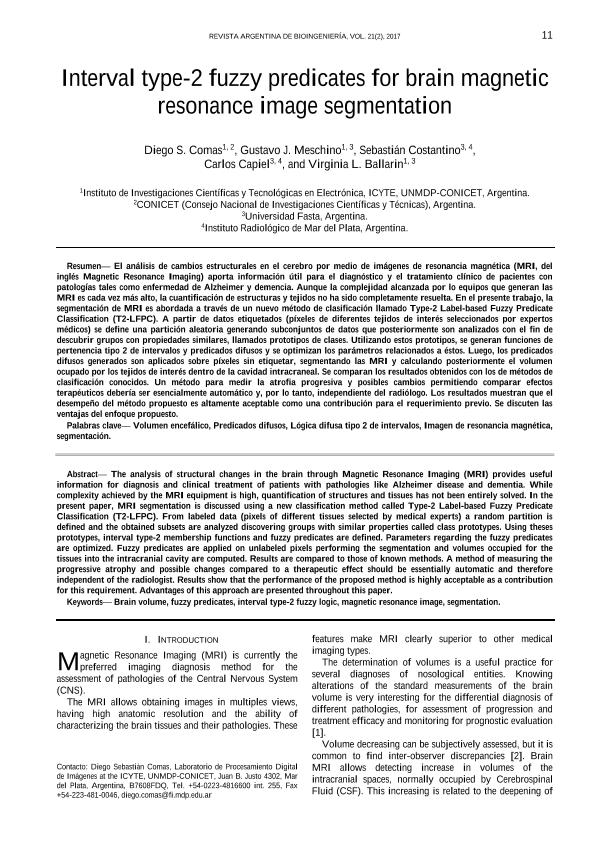Mostrar el registro sencillo del ítem
dc.contributor.author
Comas, Diego Sebastián

dc.contributor.author
Meschino, Gustavo Javier

dc.contributor.author
Costantino, Sebastián
dc.contributor.author
Capiel, Carlos
dc.contributor.author
Ballarin, Virginia Laura

dc.date.available
2018-04-23T20:22:35Z
dc.date.issued
2017-12
dc.identifier.citation
Comas, Diego Sebastián; Meschino, Gustavo Javier; Costantino, Sebastián; Capiel, Carlos; Ballarin, Virginia Laura; Interval type-2 fuzzy predicates for brain magnetic resonance image segmentation; Sociedad Argentina de Bioingeniería; Revista Argentina de Bioingeniería; 21; 2; 12-2017; 11-19
dc.identifier.issn
2591-376X
dc.identifier.uri
http://hdl.handle.net/11336/43133
dc.description.abstract
The analysis of structural changes in the brain through Magnetic Resonance Imaging (MRI) provides useful information for diagnosis and clinical treatment of patients with pathologies like Alzheimer disease and dementia. While complexity achieved by the MRI equipment is high, quantification of structures and tissues has not been entirely solved. In the present paper, MRI segmentation is discussed using a new classification method called Type-2 Label-based Fuzzy Predicate Classification (T2-LFPC). From labeled data (pixels of different tissues selected by medical experts) a random partition is defined and the obtained subsets are analyzed discovering groups with similar properties called class prototypes. Using theses prototypes, interval type-2 membership functions and fuzzy predicates are defined. Parameters regarding the fuzzy predicates are optimized. Fuzzy predicates are applied on unlabeled pixels performing the segmentation and volumes occupied for the tissues into the intracranial cavity are computed. Results are compared to those of known methods. A method of measuring the progressive atrophy and possible changes compared to a therapeutic effect should be essentially automatic and therefore independent of the radiologist. Results show that the performance of the proposed method is highly acceptable as a contribution for this requirement. Advantages of this approach are presented throughout this paper.
dc.description.abstract
The analysis of structural changes in the brain through Magnetic Resonance Imaging (MRI) provides useful information for diagnosis and clinical treatment of patients with pathologies like Alzheimer disease and dementia. While complexity achieved by the MRI equipment is high, quantification of structures and tissues has not been entirely solved. In the present paper, MRI segmentation is discussed using a new classification method called Type-2 Label-based Fuzzy Predicate Classification (T2-LFPC). From labeled data (pixels of different tissues selected by medical experts) a random partition is defined and the obtained subsets are analyzed discovering groups with similar properties called class prototypes. Using theses prototypes, interval type-2 membership functions and fuzzy predicates are defined. Parameters regarding the fuzzy predicates are optimized. Fuzzy predicates are applied on unlabeled pixels performing the segmentation and volumes occupied for the tissues into the intracranial cavity are computed. Results are compared to those of known methods. A method of measuring the progressive atrophy and possible changes compared to a therapeutic effect should be essentially automatic and therefore independent of the radiologist. Results show that the performance of the proposed method is highly acceptable as a contribution for this requirement. Advantages of this approach are presented throughout this paper.
dc.format
application/pdf
dc.language.iso
spa
dc.publisher
Sociedad Argentina de Bioingeniería
dc.rights
info:eu-repo/semantics/openAccess
dc.rights.uri
https://creativecommons.org/licenses/by-nc-sa/2.5/ar/
dc.subject
Volumen Encefálico
dc.subject
Predicados Difusos
dc.subject
Lógica Difusa Tipo 2 de Intervalos
dc.subject
Resonancia Magnética
dc.subject.classification
Ingeniería de Sistemas y Comunicaciones

dc.subject.classification
Ingeniería Eléctrica, Ingeniería Electrónica e Ingeniería de la Información

dc.subject.classification
INGENIERÍAS Y TECNOLOGÍAS

dc.title
Interval type-2 fuzzy predicates for brain magnetic resonance image segmentation
dc.type
info:eu-repo/semantics/article
dc.type
info:ar-repo/semantics/artículo
dc.type
info:eu-repo/semantics/publishedVersion
dc.date.updated
2018-04-16T13:47:55Z
dc.journal.volume
21
dc.journal.number
2
dc.journal.pagination
11-19
dc.journal.pais
Argentina

dc.journal.ciudad
Tucumán
dc.description.fil
Fil: Comas, Diego Sebastián. Consejo Nacional de Investigaciones Científicas y Técnicas. Centro Científico Tecnológico Conicet - Mar del Plata. Instituto de Investigaciones Científicas y Tecnológicas En Electronica. Universidad Nacional de Mar del Plata. Facultad de Ingeniería. Instituto de Investigaciones Científicas y Tecnológicas En Electronica.; Argentina
dc.description.fil
Fil: Meschino, Gustavo Javier. Universidad FASTA ; Argentina
dc.description.fil
Fil: Costantino, Sebastián. Consejo Nacional de Investigaciones Científicas y Técnicas. Centro Científico Tecnológico Conicet - Mar del Plata. Instituto de Investigaciones Científicas y Tecnológicas En Electronica. Universidad Nacional de Mar del Plata. Facultad de Ingeniería. Instituto de Investigaciones Científicas y Tecnológicas En Electronica.; Argentina
dc.description.fil
Fil: Capiel, Carlos. Instituto Radiologico Mar del Plata; Argentina. Universidad FASTA ; Argentina
dc.description.fil
Fil: Ballarin, Virginia Laura. Consejo Nacional de Investigaciones Científicas y Técnicas. Centro Científico Tecnológico Conicet - Mar del Plata. Instituto de Investigaciones Científicas y Tecnológicas En Electronica. Universidad Nacional de Mar del Plata. Facultad de Ingeniería. Instituto de Investigaciones Científicas y Tecnológicas En Electronica.; Argentina. Universidad FASTA ; Argentina
dc.journal.title
Revista Argentina de Bioingeniería
dc.relation.alternativeid
info:eu-repo/semantics/altIdentifier/url/http://revistasabi.fi.mdp.edu.ar/index.php/revista/article/view/94
Archivos asociados
